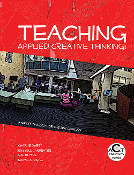Home » Resources » Scholarship on Teaching » Teaching Applied Creative Thinking: A New Pedagogy for the 21st Century (ACT Creativity Series) (Volume 2)
Scholarship
March 29, 2017
Teaching Applied Creative Thinking: A New Pedagogy for the 21st Century (ACT Creativity Series) (Volume 2)

- Author
- Sweet, Charlie; Carpenter, Rusty; Blythe, Hal; and Apostel, Shawn
- Publisher
- New Forums Press, Stillwater, OK
Click Here for Book Review
Abstract: The authors of Teaching Applied Creative Thinking: A New Pedagogy for the 21st Century believe this book to be the first in the field about teaching creative thinking in the new millennium. While many books talk about creativity and provide the justification for adding creative thinking as a student learning outcome, this book focuses on applying creativity to the teaching and learning process. The authors ask, “does anyone truly believe the world’s problems are going to be solved by students with only a high proficiency in common core competencies?”
With student learning outcomes as a goal, we must rethink teaching and learning to include creativity. Posed for the 21st-Century learner, their new paradigm, Mentor-from-the-Middle, replicates scholarly inquiry by developing a scholarly frame of mind. The teacher assumes new roles in this paradigm of scholar, mentor, facilitator, coach, model, and critical reflector. These roles in turn combine to help transform the learner into an active creative thinker.
"The authors’ goals in writing this book are to fill a void, to transform teaching, to create a new model, and to develop a new approach to teaching and learning. In the old world, before the coming of Google, the transfer of knowledge was the work of the teacher; now knowledge is available at the tip of our fingers. But the Google cannot solve the world’s problems. We will always need great teachers to transform and synthesize knowledge into skills, to teach creative thinking, to apply learning, and to create a love for learning that lasts a lifetime. The authors discuss new brain research, advanced technologies, the teaching environment, and pedagogy. They synthesize this knowledge in a wonderful way to encourage the reader to think deeply about how this research might affect the teacher and the learner. (From the Publisher)
Abstract: The authors of Teaching Applied Creative Thinking: A New Pedagogy for the 21st Century believe this book to be the first in the field about teaching creative thinking in the new millennium. While many books talk about creativity and provide the justification for adding creative thinking as a student learning outcome, this book focuses on applying creativity to the teaching and learning process. The authors ask, “does anyone truly believe the world’s problems are going to be solved by students with only a high proficiency in common core competencies?”
With student learning outcomes as a goal, we must rethink teaching and learning to include creativity. Posed for the 21st-Century learner, their new paradigm, Mentor-from-the-Middle, replicates scholarly inquiry by developing a scholarly frame of mind. The teacher assumes new roles in this paradigm of scholar, mentor, facilitator, coach, model, and critical reflector. These roles in turn combine to help transform the learner into an active creative thinker.
"The authors’ goals in writing this book are to fill a void, to transform teaching, to create a new model, and to develop a new approach to teaching and learning. In the old world, before the coming of Google, the transfer of knowledge was the work of the teacher; now knowledge is available at the tip of our fingers. But the Google cannot solve the world’s problems. We will always need great teachers to transform and synthesize knowledge into skills, to teach creative thinking, to apply learning, and to create a love for learning that lasts a lifetime. The authors discuss new brain research, advanced technologies, the teaching environment, and pedagogy. They synthesize this knowledge in a wonderful way to encourage the reader to think deeply about how this research might affect the teacher and the learner. (From the Publisher)